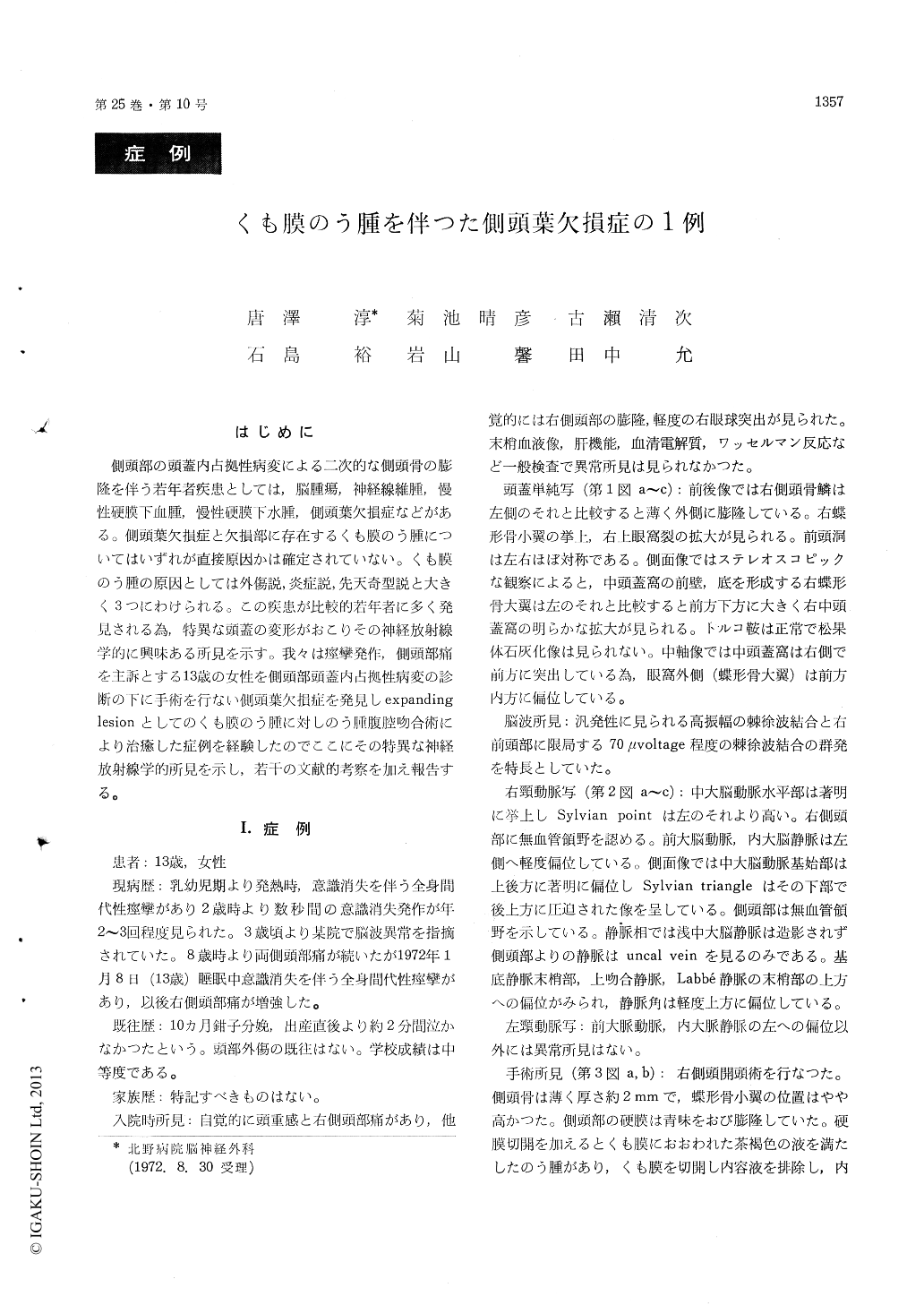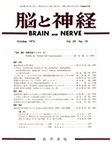Japanese
English
- 有料閲覧
- Abstract 文献概要
- 1ページ目 Look Inside
はじめに
側頭部の頭蓋内占拠性病変による二次的な側頭骨の膨隆を伴う若年者疾患としては,脳腫瘍,神経線維腫,慢性硬膜下血腫,慢性硬膜下水腫,側頭葉欠損症などがある。側頭葉欠損症と欠損部に存在するくも膜のう腫についてはいずれが直接原因かは確定されていない。くも膜のう腫の原因としては外傷説,炎症説,先天奇型説と大きく3つにわけられる。この疾患が比較的若年者に多く発見される為,特異な頭蓋の変形がおこりその神経放射線学的に興味ある所見を示す。我々は痙攣発作,側頭部痛を主訴とする13歳の女性を側頭部頭蓋内占拠性病変の診断の下に手術を行ない側頭葉欠損症を発見しexpandinglesionとしてのくも膜のう腫に対しのう腫腹腔吻合術により治癒した症例を経験したのでここにその特異な神経放射線学的所見を示し,若干の文献的考察を加え報告する。
The patient was a 13-year-old female with thechief complaints of temporalgia and convulsion. She visited our department on February 1, 1972. The patient suffered from clonic convulsion from her infant age and abnormality of encephalogram was pointed out at the age of 3. She complained of bitemporalgia at the age of 8 and her right temporalgia gradually aggravated. When seen for the first time, bulging of right temporal region and right exophthalmus were recorded but neuro-logical signs were absent. Plain skull roentgenolo-graphy revealed that right temporal bone is thin and bulged outside. There were other findings : elevation of the right lesser wing of the sphenoid, enlargement of the right superior orbital fissure, large right greater wing of the sphenoid and en-largement of the right middle fossa. The right carotid angiography showed that the proximal part of middle cerebral artery remarkably elevated and Sylvian point on the right was higher than the left. Avascular area was observed at the right temporal region. There was a slight shift of the anterior cerebral artery and the internal cerebral vein toward the left side. The lower part of the Sylvian triangle was oppressed upward right. In venous phase, the Sylvian veins were not reflected and the uncal vein only was seen at the temporal region. The venous angle and the distal part of the basilar vein, the rolandic vein, and the vein of Labbe were deviated upward. On March 15 a right front-parieto-temporal osteoplastic craniotomy was performed. The dura of the temporal region bulged and a opening the dura revealed cyst filled with brown fluid. The cyst was covered with the arachnoidal membrane and the fluid was removed.
Agenesis of the anterior part of the temporal lobe and arachnoidal cyst were observed. The cyst had a closed cavity and there was no con-nection with subarachnoidal space. Atrophic pat-tern of the brain around the part of the agenesis was not seen.
After surgery, since temporalgia and convulsion disappeared, the patient left the hospital on April 7. Air was poured into cyst to measure the size of agenesis of the temporal lobe after operation. The air in the cyst did not flow out to the sub-arachnoidal cavity even on the following day. After discharge of the hospital, the patient experi-enced a recurrence of temporalgia and convulsion so that we performed a cystabdominal shunt on her. Later headache and abdominal fullness in a sitting position were manifested and 60mm H2O by spinal tap was recorded. The content of C.F.S. at spinal tap was similar to that of cyst collected at the same time. As headache disappeared, right carotid angiography was employed again, whereby it was revealed that the anterior cerebral artery and the internal cerebral vein were slightly shifted to the left but the middle cerebral artery run normally. A pneumoencephalography showed that the temporal horn of the lateral ventricle was symmetrical and that there was not a finding ofenlargement of the ventricle.
As to agenesis of temporal lobe and arachnoidal cyst in the area of agenesis, a question that the former would be direct cause to the latter or vice versa still remains unsolved. In this case deformity of the skull was thought to be produced by the enlargement of arachnoidal cyst. This is a reasonalbe interpretation from the fact that arachnoidal cyst was found to have a closed cavity by operative findings and headache and convulsion that existed as subjective symptoms disappeared by the em-ployment of cystabdominal shunt, and that angio-graphy used after that provided normal finding. The air injected into arachnoidal cyst did not flow out to subarachnoidal cavity and lower pressure C.S.F. syndrom appeared after cyst abdominal shunt.
Taking these facts into consideration, it can certainly be thought there is 'a one way value' mechanism from subarachnoidal cavity to arachnoid cyst. Existences of headache, exophthalmus and bulging of temporal bone, proved that arachnoidal cyst is primary, while those of no atrophic pattern in the surface of the brain and loss of Sylvian vein do that agenesis of temporal lobe is primary. Therefore it is difficult to dicide whether one is primary or the other.

Copyright © 1973, Igaku-Shoin Ltd. All rights reserved.


